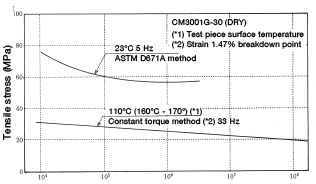
Figure 5-1: Flexural fatigue properties
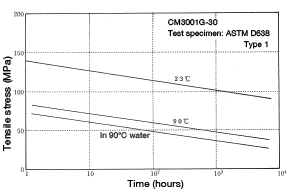
Figure 5-2: Creep rupture properties
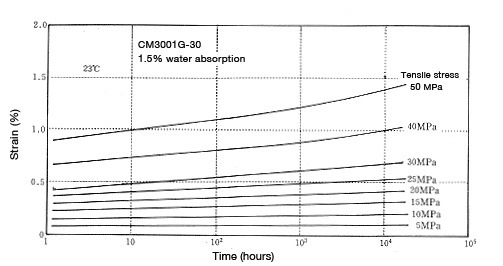
Figure 5-3: Tensile creep properties
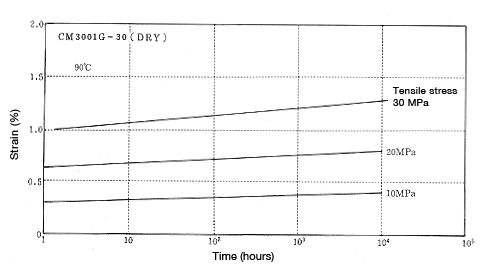
Figure 5-4: Tensile creep properties

Figure 5-5: Tensile creep properties
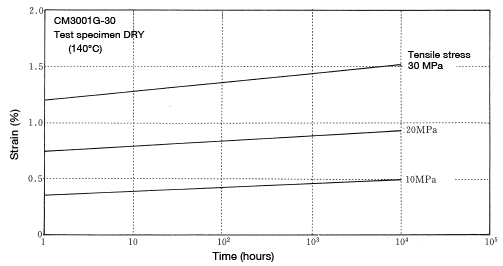
Figure 5-6: Tensile creep properties
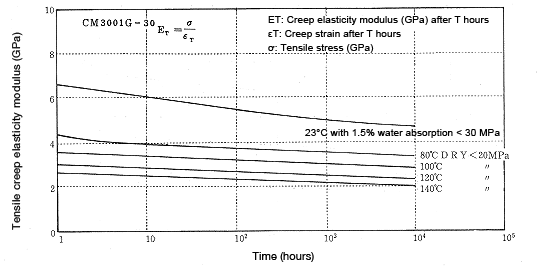
Figure 5-7: Change in creep elasticity as a function of temperature
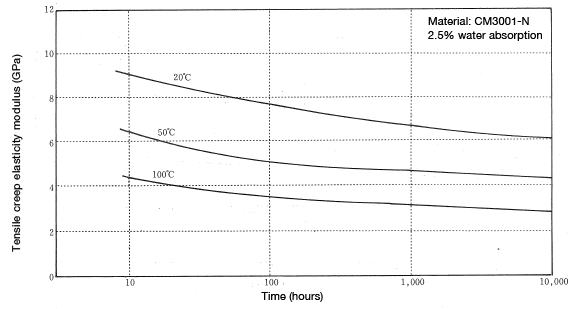
Figure 5-8: Change in creep elasticity as a function of temperature
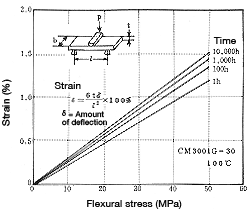 Figure 5-9: Stress-time-strain curve
Figure 5-9: Stress-time-strain curve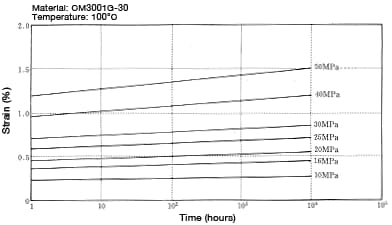 Figure 5-10: Flexural creep properties
Figure 5-10: Flexural creep properties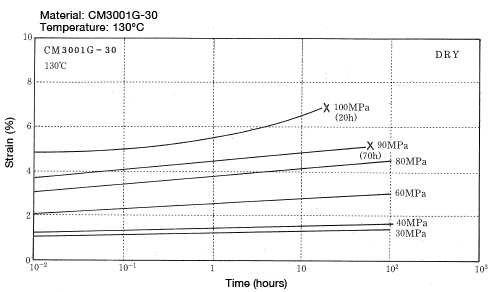
Figure 5-11: Flexural creep properties
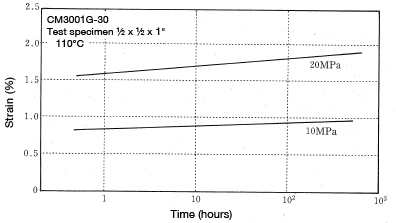
Figure 5-12: Compressive creep properties
(for reference)
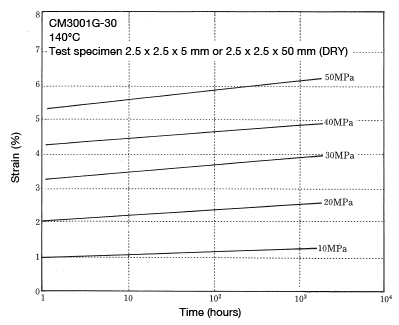
Figure 5-13: Compressive creep properties
(for reference)
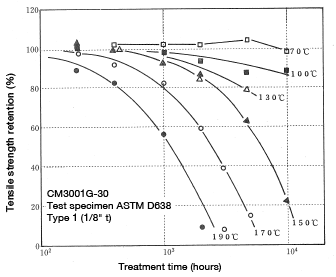 Figure 5-14: Change in tensile strength resulting from thermal degradation
Figure 5-14: Change in tensile strength resulting from thermal degradation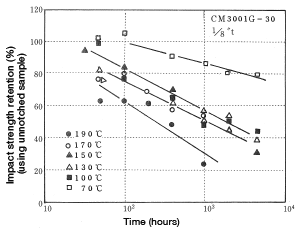 Figure 5-15: Change in impact strength resulting from thermal degradation
Figure 5-15: Change in impact strength resulting from thermal degradation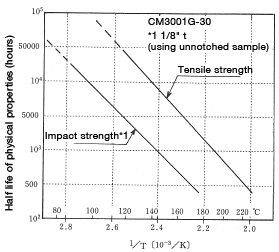
Figure 5-16: Heat life curve
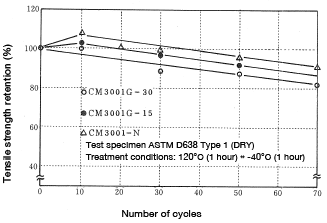
Figure 5-17: Change in tensile strength resulting from heat shock
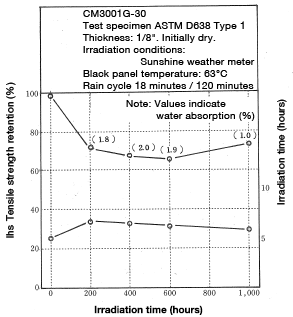 Figure 5-18: Change in tensile strength under weather-meter irradiation
Figure 5-18: Change in tensile strength under weather-meter irradiation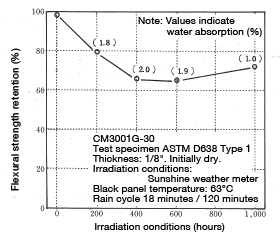 Figure 5-19: Change in flexural strength under weather meter irradiation
Figure 5-19: Change in flexural strength under weather meter irradiation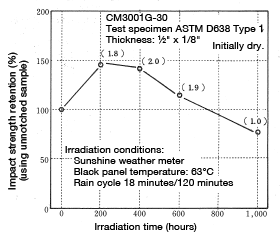 Figure 5-20: Change in impact strength under weather meter irradiation
Figure 5-20: Change in impact strength under weather meter irradiation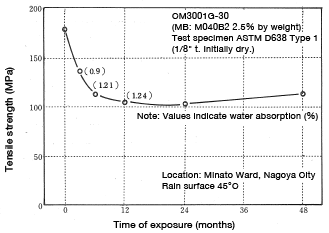 Figure 5-21: Change in tensile strength under exposure to the outdoors
Figure 5-21: Change in tensile strength under exposure to the outdoors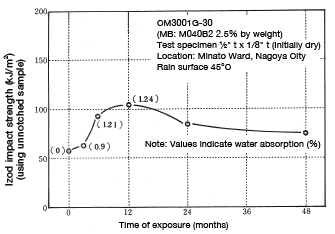
Figure 5-22: Change in impact strength under exposure to the outdoors
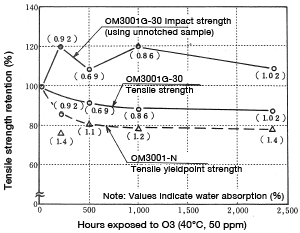
Figure 5-23: Change in properties resulting from ozone exposure
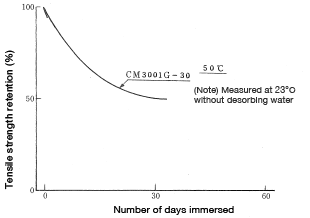 Figure 5-24: Change in tensile strength resulting from immersion in warm water (50°C)
Figure 5-24: Change in tensile strength resulting from immersion in warm water (50°C)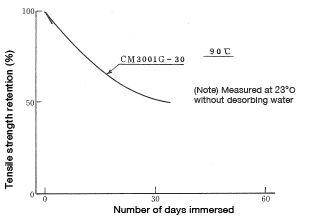 Figure 5-25: Change in tensile strength resulting from immersion in hot water (90°C)
Figure 5-25: Change in tensile strength resulting from immersion in hot water (90°C)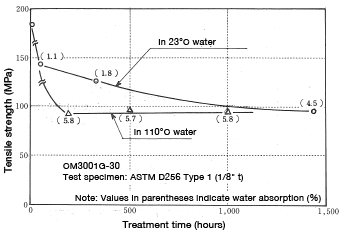
Figure 5-26: Change in tensile strength resulting from immersion in hot water
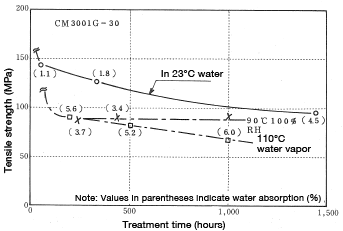
Figure 5-27: Change in tensile strength resulting from treatment with hot water vapor
| Grade | Treatment temperature (°C) |
Treatment time (h) |
Tensile strength (MPa) |
Breaking elongation (%) |
Impact strength※ (kJ/m2) |
Weight change (%) |
Dimensional change (%) |
|---|---|---|---|---|---|---|---|
| CM3001G-30 | 130 | 0 | 183 | 5.6 | 65 | - | - |
| 130 | 600 | 172 | 5.6 | 55 | +0.57 | +0.01 | |
| CM3001-N | 120 | 0 | 85 | 116 | - | - | - |
| 120 | 400 | 85 | 63 | - | +0.64 | - | |
| 120 | 600 | 84 | 70 | - | +0.77 | - |
※ Impact strength (using unnotched sample)
| Treatment time (h) |
Tensile strength (MPa) |
Breaking elongation (%) |
Flexural strength (MPa) |
Flexural modulus (GPa) |
Izod impact strength (J/m) |
Weight change (%) |
Dimensional change (%) |
|---|---|---|---|---|---|---|---|
| 0 | 177 | 4.6 | 261 | 9.3 | 111 | - | - |
| 100 | 174 | 4.7 | 252 | 8.6 | 108 | +0.20 | 0 |
| 300 | 174 | 4.4 | 257 | 9.2 | 105 | +0.20 | 0 |
| 500 | 173 | 4.6 | 257 | 9.2 | 110 | +0.18 | 0 |
| 1,000 | 165 | 5.0 | 247 | 8.9 | 102 | +0.44 | 0 |
| Treatment time (h) |
Tensile strength (MPa) |
Breaking elongation (%) |
Flexural strength (MPa) |
Flexural modulus (GPa) |
Izod impact strength (J/m) |
Weight change (%) |
Dimensional change (%) |
|---|---|---|---|---|---|---|---|
| 0 | 177 | 4.6 | 261 | 9.3 | 111 | - | - |
| 100 | 178 | 4.6 | 257 | 9.2 | 107 | +0.05 | 0 |
| 300 | 178 | 4.5 | 257 | 9.2 | 103 | +0.10 | 0 |
| 500 | 177 | 4.6 | 259 | 9.5 | 103 | +0.07 | 0 |
| 1,000 | 176 | 4.8 | 257 | 9.4 | 102 | +0.10 | 0 |
| Chemical name | Tensile strength (MPa) |
Breaking elongation (%) |
Izod impact strength (J/m) |
Weight change (%) |
|---|---|---|---|---|
| Blank | 178 | 5.0 | 610 | - |
| Toyota CASTLE Special 20w/40SD | 177 | 5.5 | 420 | +0.1 |
| Nissan Motor Oil Super 20w/40 | 174 | 5.4 | 450 | +0.1 |
| Honda ULTRAS SAE10w/30 | 174 | 5.5 | 460 | +0.3 |
| Mitsubishi DIAMOND Deluxe APSE | 175 | 5.5 | 420 | +0.1 |
| Chemical name | Cycles | Tensile strength (MPa) |
Breaking strength (%) |
Flexural strength (MPa) |
Flexural modulus (Gpa) |
※2 Izod impact strength (kJ/m2) |
|---|---|---|---|---|---|---|
| Blank | - | 185 | 5.2 | 270 | 9.91 | 68 |
| Ethylene glycol (Reagent grade 1) |
1 | 186※1 (190) |
5.2 (5.2) |
269 (269) |
9.20 (9.50) |
69 (72) |
| 3 | 191 (199) |
5.3 (5.0) |
269 (268) |
8.83 (9.27) |
73 (75) |
|
| 5 | 191 (199) |
5.3 (5.0) |
269 (268) |
8.78 (9.42) |
69 (73) |
|
| Washer fluid (Toyota brand) |
1 | 186 (191) |
5.6 (5.8) |
265 (268) |
9.10 (9.70) |
64 (71) |
| 3 | 188 (196) |
5.7 (6.0) |
262 (265) |
8.65 (9.65) |
62 (70) |
|
| 5 | 190 (195) |
5.2 (5.4) |
258 (270) |
8.53 (9.63) |
63 (69) |
|
| Brake fluid (NR-3) |
1 | 185 (182) |
5.3 (5.4) |
264 (274) |
9.40 (9.69) |
65 (72) |
| 3 | 192 (198) |
5.6 (6.0) |
259 (275) |
8.74 (9.59) |
66 (78) |
|
| 5 | 193 (192) |
5.0 (5.3) |
257 (270) |
9.10 (9.37) |
69 (75) |
|
| LLC fluid (CASTLE Special) |
1 | 187 (190) |
5.5 (5.8) |
265 (270) |
9.80 (9.54) |
70 (69) |
| 3 | 188 (197) |
5.4 (6.0) |
264 (284) |
9.00 (9.35) |
62 (73) |
|
| 5 | 191 (196) |
5.2 (5.7) |
258 (271) |
8.96 (9.40) |
63 (72) |
|
| Water (Tap water) |
1 | 189 (191) |
5.3 (5.2) |
267 (271) |
9.02 (9.74) |
69 (76) |
| 3 | 195 (200) |
5.2 (5.0) |
261 (272) |
8.71 (9.42) |
67 (74) |
|
| 5 | 192 (199) |
5.2 (5.4) |
251 (279) |
8.34 (9.39) |
70 (72) |
※1, Dried (120°C, 760mmHg, 24h) product
※2, Unnotched sample.
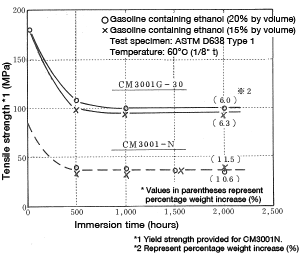 Figure 5-28: Change in tensile strength resulting from immersion in gasohol
Figure 5-28: Change in tensile strength resulting from immersion in gasohol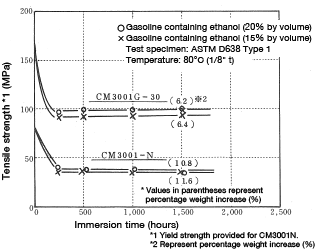 Figure 5-29: Change in tensile strength resulting from immersion in gasohol (at 80°C)
Figure 5-29: Change in tensile strength resulting from immersion in gasohol (at 80°C)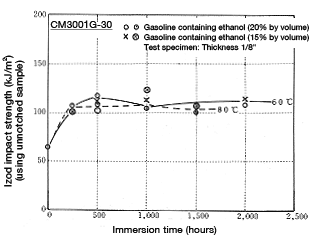 Figure 5-30: Change in impact strength resulting from immersion in gasohol
Figure 5-30: Change in impact strength resulting from immersion in gasohol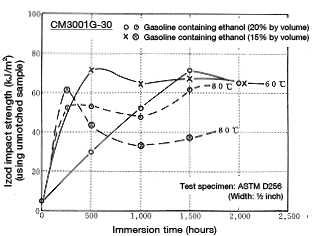 Figure 5-31: Change in impact strength resulting from immersion in gasohol
Figure 5-31: Change in impact strength resulting from immersion in gasohol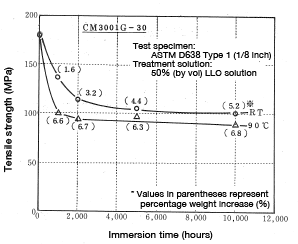
Figure 5-32: Change in tensile strength resulting from immersion in 50% LLC aqueous solution

 Vietnam
Vietnam